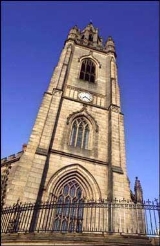
Church of Our Lady and Saint Nicholas, Liverpool
Encyclopedia
The Church of Our Lady and Saint Nicholas is the Anglican parish church
of Liverpool
. The site is said to have been a place of worship since at least 1257. The church is situated close to the River Mersey
near the Pier Head
. The Chapel
of St Nicholas (Patron Saint of Sailors) was built on the site of St Mary del Quay, which in 1355 was determined to be too small for the growing borough of Liverpool. It is a Grade II listed building and an active parish church in the diocese of Liverpool
, the archdeaconry of Liverpool and the deanery of Liverpool North.
. By 1257 a small stone chapel known as St Mary del Quay had been built. It probably stood near the site of the present tower, overlooking a quay on the River Mersey
. The chapel was used as the main centre of worship until 1355. A new chapel dedicated to St Mary and St Nicholas was built on land granted to the burgesses by the Duke of Lancaster
. It was under construction for more than a century.
In 1361 a plague hit the town and the Bishop of Lichfield and Coventry licensed the burial ground. The chapel was consecrated the following year. By the late 15th century, a north aisle, the same size as the original nave
, had been added, and three chantry altars had been established. Each chantry
had its own priest paid for by a wealthy patron. In 1515 a fourth chantry was built.
, the chantries were abolished. The building was adapted in stages to suit the form of worship found in the Book of Common Prayer
. Between 1673 and 1718, the building was extended piecemeal, and galleries were built to seat the increasing population of Liverpool. A spire was added in 1746.
In 1699 Liverpool, now with a population of about 5,000 people, was created an independent parish with (unusually) two parish churches and two rectors. Our Lady and St Nicholas (the "Old Church" or St Nicks) and the new parish church of St Peter's were established as the parish churches. In 1775, the parish decided to rebuild the walls of the existing church. The galleries were kept, as the congregation paid pew
rents. A new roof was set atop classical columns, which rested on medieval bases. The reconstructed church had walls four feet longer than the original structure.
By the year 1865, there were 27 churches in the parish, housing around 275,000 people. Since 1916 Our Lady and St Nicholas has been the Parish Church
of Liverpool. St Peter's, which was situated in Church Street, was demolished in 1922, having served as pro-cathedral for the Anglican Diocese of Liverpool
.
Between 1811 and 1815, a new tower and lantern were built at the north side of the church. The tower was designed by Thomas Harrison
of Chester
. The last remains of the original chapel of St Mary del Quay, which had been used as a tavern, were demolished. Within the tower, a new ring of 12 bells was installed, cast by Dobson of Downham Market. The Tenor bell was recast by Warners in 1912.
Over the years, several small changes were made to the church for liturgical reasons. The most notable changes occurred between 1851 and 1852. The Parish Centre was built in the 1920s to accommodate community life and a church school. Apart from these changes, the church remained the same between 1815 and 1940.
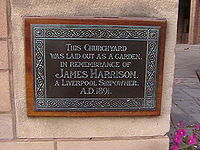
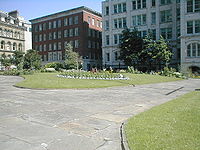
, the bells were removed for safety, but they were never rehung. Following a German air raid on 21 December 1940, the main body of the church was destroyed by fire, leaving only the parish rooms, vestries and the 19th century tower. Rebuilding did not begin until March 1949, and the church was consecrated in 18 October 1952 (the Feast of St Luke). A new ring of 12 bells was cast by John Taylor and Co. of Loughborough
.
The new church was designed by architect Edward C. Butler, who introduced major changes to its design. Rather than the traditional practice of placing the altar at the east end (for the light of the rising sun and to signify the Resurrection
), Butler placed it at the western end of the church.
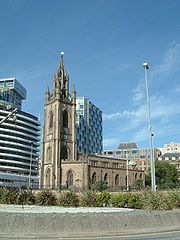 Unlike churches in which the pulpit is traditionally the most prominent feature, Butler emphasized the sanctuary
Unlike churches in which the pulpit is traditionally the most prominent feature, Butler emphasized the sanctuary
. He excluded the galleries, which had helped seat the historically large congregations. This decision reflected the smaller contemporary congregations. The nave was designed as 46 ft (14m) taller in the new church. The positions of the organ and Refectory
were changed; situated above the Narthex
(entrance vestibule), they reduced the seating space within the church.
 The exterior of the church is notable for its distinctive lantern spire, which can be easily spotted from the river, despite being overshadowed by many taller buildings of the city's business district. The nave and the sanctuary house fixed woodwork carved with the vine as the dominant motif, referencing Christ: "I am the vine, you are the branches". In the southeast corner of the church is a stained glass window: Our Lady stands in glory as in Revelation and St Nicholas holds a ship. An inscription reads: "For the Healing of the Nations". A war memorial for the Cunard Steamship Company
The exterior of the church is notable for its distinctive lantern spire, which can be easily spotted from the river, despite being overshadowed by many taller buildings of the city's business district. The nave and the sanctuary house fixed woodwork carved with the vine as the dominant motif, referencing Christ: "I am the vine, you are the branches". In the southeast corner of the church is a stained glass window: Our Lady stands in glory as in Revelation and St Nicholas holds a ship. An inscription reads: "For the Healing of the Nations". A war memorial for the Cunard Steamship Company
, placed in the church in 1989, is in the north east corner. The church organ is by Rushworth and Dreaper
of Liverpool, and is dedicated to the memory of Charles W. Bridson, organist 1902-1949. Hanging between the nave and the sanctuary is the Rood
, a figure of Christ with Our Lady and St John
. The Rood is carved from the old oak bell frame from the tower.
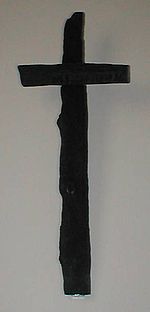
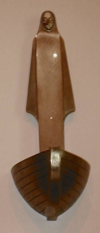 Two chapels are on each side of the altar, St Peter's on the left and St Mary's on the right. The Chapel of St Peter commemorates the old co-parish church of St Peter's, which stood on Church Street. The 18th-century wooden table was once the altar there. The Sacrament
Two chapels are on each side of the altar, St Peter's on the left and St Mary's on the right. The Chapel of St Peter commemorates the old co-parish church of St Peter's, which stood on Church Street. The 18th-century wooden table was once the altar there. The Sacrament
is reserved here, and the chapel is used for weekday Communion services. Charred timbers from the old church were used to form the cross on the wall.
The Maritime Chapel of St Mary del Quay was dedicated in 1993 as part of the celebrations for the 50th anniversary of The Battle of the Atlantic
. It memorializes the medieval shrine. A statue of Our Lady, cast in bronze, is shown standing in the prow of a boat. The statue was created by Liverpool artist Arthur Dooley
. The furnishings in the chapel are by Robin McGhie. The chapel contains a Book of Remembrance, listing the names of mariners lost at sea.
The church is linked to the famous phrase, "I'll be waiting till Dick docks", meaning "I'll be waiting a long time". This refers to the ship the Richard Donnelly, which is said to have sunk in Liverpool Bay
. Another version of this phrase is used when an unlikely promise is made; "I'll repay that loan soon!" "Oh,yes - when Donnelly docks!" implying that the action is never going to happen. A gilded copper
weather vane in the form of the ship is on top of the tower of St Nicholas'. The weather vane measures 4 ft 4 (1.3m).
The vane probably survived the fall of the tower in 1811. It was renovated before re-erection; the sails are dated 1815. Historic photos show ships as weather vanes on the Bluecoat Hospital and one of the Goree warehouses. The vane was added to the church in 1746 when the spire was built on the tower. The illustration in Enfield's History of Liverpool 1773 clearly shows the ship.
Despite the traditions, no record of a Liverpool ship named Donnely or Richard Donnelly has been found. recorded. This has been confirmed by Mr Tibble, Director of the Liverpool Maritime Museum. Unfortunately for local mythology, there is some serious misunderstanding about the weather vane. The facts are as supplied by David Bazendale - the Rector's Adviser on Parish History.
Parish church
A parish church , in Christianity, is the church which acts as the religious centre of a parish, the basic administrative unit of episcopal churches....
of Liverpool
Liverpool
Liverpool is a city and metropolitan borough of Merseyside, England, along the eastern side of the Mersey Estuary. It was founded as a borough in 1207 and was granted city status in 1880...
. The site is said to have been a place of worship since at least 1257. The church is situated close to the River Mersey
River Mersey
The River Mersey is a river in North West England. It is around long, stretching from Stockport, Greater Manchester, and ending at Liverpool Bay, Merseyside. For centuries, it formed part of the ancient county divide between Lancashire and Cheshire....
near the Pier Head
Pier Head
The Pier Head is a riverside location in the city centre of Liverpool, England. It is part of the Liverpool Maritime Mercantile City UNESCO World Heritage Site, which was inscribed in 2004....
. The Chapel
Chapel
A chapel is a building used by Christians as a place of fellowship and worship. It may be part of a larger structure or complex, such as a church, college, hospital, palace, prison or funeral home, located on board a military or commercial ship, or it may be an entirely free-standing building,...
of St Nicholas (Patron Saint of Sailors) was built on the site of St Mary del Quay, which in 1355 was determined to be too small for the growing borough of Liverpool. It is a Grade II listed building and an active parish church in the diocese of Liverpool
Anglican Diocese of Liverpool
The Diocese of Liverpool is a Church of England diocese based in Liverpool, covering Merseyside north of the River Mersey along with West Lancashire, Wigan in Greater Manchester, Warrington and Widnes in Cheshire...
, the archdeaconry of Liverpool and the deanery of Liverpool North.
St Mary del Quay
In 1207 Liverpool received its charter from King JohnJohn of England
John , also known as John Lackland , was King of England from 6 April 1199 until his death...
. By 1257 a small stone chapel known as St Mary del Quay had been built. It probably stood near the site of the present tower, overlooking a quay on the River Mersey
River Mersey
The River Mersey is a river in North West England. It is around long, stretching from Stockport, Greater Manchester, and ending at Liverpool Bay, Merseyside. For centuries, it formed part of the ancient county divide between Lancashire and Cheshire....
. The chapel was used as the main centre of worship until 1355. A new chapel dedicated to St Mary and St Nicholas was built on land granted to the burgesses by the Duke of Lancaster
Henry of Grosmont, 1st Duke of Lancaster
Henry of Grosmont, 1st Duke of Lancaster, 4th Earl of Leicester and Lancaster, KG , also Earl of Derby, was a member of the English nobility in the 14th century, and a prominent English diplomat, politician, and soldier...
. It was under construction for more than a century.
In 1361 a plague hit the town and the Bishop of Lichfield and Coventry licensed the burial ground. The chapel was consecrated the following year. By the late 15th century, a north aisle, the same size as the original nave
Nave
In Romanesque and Gothic Christian abbey, cathedral basilica and church architecture, the nave is the central approach to the high altar, the main body of the church. "Nave" was probably suggested by the keel shape of its vaulting...
, had been added, and three chantry altars had been established. Each chantry
Chantry
Chantry is the English term for a fund established to pay for a priest to celebrate sung Masses for a specified purpose, generally for the soul of the deceased donor. Chantries were endowed with lands given by donors, the income from which maintained the chantry priest...
had its own priest paid for by a wealthy patron. In 1515 a fourth chantry was built.
Reformation and beyond
During the English ReformationEnglish Reformation
The English Reformation was the series of events in 16th-century England by which the Church of England broke away from the authority of the Pope and the Roman Catholic Church....
, the chantries were abolished. The building was adapted in stages to suit the form of worship found in the Book of Common Prayer
Book of Common Prayer
The Book of Common Prayer is the short title of a number of related prayer books used in the Anglican Communion, as well as by the Continuing Anglican, "Anglican realignment" and other Anglican churches. The original book, published in 1549 , in the reign of Edward VI, was a product of the English...
. Between 1673 and 1718, the building was extended piecemeal, and galleries were built to seat the increasing population of Liverpool. A spire was added in 1746.
In 1699 Liverpool, now with a population of about 5,000 people, was created an independent parish with (unusually) two parish churches and two rectors. Our Lady and St Nicholas (the "Old Church" or St Nicks) and the new parish church of St Peter's were established as the parish churches. In 1775, the parish decided to rebuild the walls of the existing church. The galleries were kept, as the congregation paid pew
Pew
A pew is a long bench seat or enclosed box used for seating members of a congregation or choir in a church, or sometimes in a courtroom.-Overview:Churches were not commonly furnished with permanent pews before the Protestant Reformation...
rents. A new roof was set atop classical columns, which rested on medieval bases. The reconstructed church had walls four feet longer than the original structure.
By the year 1865, there were 27 churches in the parish, housing around 275,000 people. Since 1916 Our Lady and St Nicholas has been the Parish Church
Parish church
A parish church , in Christianity, is the church which acts as the religious centre of a parish, the basic administrative unit of episcopal churches....
of Liverpool. St Peter's, which was situated in Church Street, was demolished in 1922, having served as pro-cathedral for the Anglican Diocese of Liverpool
Anglican Diocese of Liverpool
The Diocese of Liverpool is a Church of England diocese based in Liverpool, covering Merseyside north of the River Mersey along with West Lancashire, Wigan in Greater Manchester, Warrington and Widnes in Cheshire...
.
Disaster befalls the church
Over the years, as new churches were built, the "Old Church" continued to serve a congregation. Members repeatedly warned officials that the spire was unsafe. On Sunday 11 February 1810, as the bells rang and people were gathering for the morning service, the spire crashed into the nave below, killing 25 people. Twenty-one were under 15 years old, and most were girls from Moorfields Charity School. The original ring of six bells, dating from 1636-1724, was destroyed in the disaster. An eyewitness account is found in Stonehouse's Recollections of Old Liverpool.Between 1811 and 1815, a new tower and lantern were built at the north side of the church. The tower was designed by Thomas Harrison
Thomas Harrison (architect)
Thomas Harrison was an English architect and engineer. He built a number of bridges, including Grosvenor Bridge in Chester. He also rebuilt parts of Chester and Lancaster castles...
of Chester
Chester
Chester is a city in Cheshire, England. Lying on the River Dee, close to the border with Wales, it is home to 77,040 inhabitants, and is the largest and most populous settlement of the wider unitary authority area of Cheshire West and Chester, which had a population of 328,100 according to the...
. The last remains of the original chapel of St Mary del Quay, which had been used as a tavern, were demolished. Within the tower, a new ring of 12 bells was installed, cast by Dobson of Downham Market. The Tenor bell was recast by Warners in 1912.
Over the years, several small changes were made to the church for liturgical reasons. The most notable changes occurred between 1851 and 1852. The Parish Centre was built in the 1920s to accommodate community life and a church school. Apart from these changes, the church remained the same between 1815 and 1940.


Closure and transformation of the churchyard
The churchyard used to be surrounded by walls. From 1758 to 1772, a battery of guns stood on an area of the burial ground (now covered by road) to defend the river. Until 1767, when Georges Dock was built where the Liver Building now stands, the River Mersey reached the church garden walls at high tide. In 1849 the churchyard was closed to burials. In 1891 it was transformed into a public garden in memory of James Harrison, whose shipping company had its offices facing the churchyard until the early 21st century.Destruction and rebuilding of the church
During World War IIWorld War II
World War II, or the Second World War , was a global conflict lasting from 1939 to 1945, involving most of the world's nations—including all of the great powers—eventually forming two opposing military alliances: the Allies and the Axis...
, the bells were removed for safety, but they were never rehung. Following a German air raid on 21 December 1940, the main body of the church was destroyed by fire, leaving only the parish rooms, vestries and the 19th century tower. Rebuilding did not begin until March 1949, and the church was consecrated in 18 October 1952 (the Feast of St Luke). A new ring of 12 bells was cast by John Taylor and Co. of Loughborough
John Taylor Bellfounders
John Taylor & Co, formerly trading as Taylors, Eayre & Smith Ltd and John Taylor Bellfounders Ltd, and commonly known as Taylor's Bell Foundry or simply Taylor's, is the world's largest working bell foundry, located in Loughborough in the United Kingdom.The company manufactures bells for use in...
.
The new church was designed by architect Edward C. Butler, who introduced major changes to its design. Rather than the traditional practice of placing the altar at the east end (for the light of the rising sun and to signify the Resurrection
Resurrection
Resurrection refers to the literal coming back to life of the biologically dead. It is used both with respect to particular individuals or the belief in a General Resurrection of the dead at the end of the world. The General Resurrection is featured prominently in Jewish, Christian, and Muslim...
), Butler placed it at the western end of the church.

Sanctuary
A sanctuary is any place of safety. They may be categorized into human and non-human .- Religious sanctuary :A religious sanctuary can be a sacred place , or a consecrated area of a church or temple around its tabernacle or altar.- Sanctuary as a sacred place :#Sanctuary as a sacred place:#:In...
. He excluded the galleries, which had helped seat the historically large congregations. This decision reflected the smaller contemporary congregations. The nave was designed as 46 ft (14m) taller in the new church. The positions of the organ and Refectory
Refectory
A refectory is a dining room, especially in monasteries, boarding schools and academic institutions. One of the places the term is most often used today is in graduate seminaries...
were changed; situated above the Narthex
Narthex
The narthex of a church is the entrance or lobby area, located at the end of the nave, at the far end from the church's main altar. Traditionally the narthex was a part of the church building, but was not considered part of the church proper...
(entrance vestibule), they reduced the seating space within the church.
Exterior and interior detailing

Cunard Line
Cunard Line is a British-American owned shipping company based at Carnival House in Southampton, England and operated by Carnival UK. It has been a leading operator of passenger ships on the North Atlantic for over a century...
, placed in the church in 1989, is in the north east corner. The church organ is by Rushworth and Dreaper
Rushworth and Dreaper
Rushworth and Dreaper was a firm of organ builders based in Liverpool, England Upon its bankruptcy, its archives were mostly destroyed, and the Victorian clock in the works tower was removed...
of Liverpool, and is dedicated to the memory of Charles W. Bridson, organist 1902-1949. Hanging between the nave and the sanctuary is the Rood
Rood
A rood is a cross or crucifix, especially a large one in a church; a large sculpture or sometimes painting of the crucifixion of Jesus.Rood is an archaic word for pole, from Old English rōd "pole", specifically "cross", from Proto-Germanic *rodo, cognate to Old Saxon rōda, Old High German ruoda...
, a figure of Christ with Our Lady and St John
John the Apostle
John the Apostle, John the Apostle, John the Apostle, (Aramaic Yoħanna, (c. 6 - c. 100) was one of the Twelve Apostles of Jesus. He was the son of Zebedee and Salome, and brother of James, another of the Twelve Apostles...
. The Rood is carved from the old oak bell frame from the tower.


Sacrament
A sacrament is a sacred rite recognized as of particular importance and significance. There are various views on the existence and meaning of such rites.-General definitions and terms:...
is reserved here, and the chapel is used for weekday Communion services. Charred timbers from the old church were used to form the cross on the wall.
The Maritime Chapel of St Mary del Quay was dedicated in 1993 as part of the celebrations for the 50th anniversary of The Battle of the Atlantic
Second Battle of the Atlantic
The Battle of the Atlantic was the longest continuous military campaign in World War II, running from 1939 to the defeat of Germany in 1945. At its core was the Allied naval blockade of Germany, announced the day after the declaration of war, and Germany's subsequent counter-blockade. It was at its...
. It memorializes the medieval shrine. A statue of Our Lady, cast in bronze, is shown standing in the prow of a boat. The statue was created by Liverpool artist Arthur Dooley
Arthur Dooley
Arthur Dooley was a British artist and sculptor. He was born in the city of Liverpool, Dooley commenced employment as a welder at Cammell Laird shipyard in Birkenhead, he also worked at the Dunlop factory in Speke, before his ambition took him to work as a cleaner at St...
. The furnishings in the chapel are by Robin McGhie. The chapel contains a Book of Remembrance, listing the names of mariners lost at sea.
The church is linked to the famous phrase, "I'll be waiting till Dick docks", meaning "I'll be waiting a long time". This refers to the ship the Richard Donnelly, which is said to have sunk in Liverpool Bay
Liverpool Bay
Liverpool Bay is a bay of the Irish Sea between northeast Wales, Cheshire, Lancashire and Merseyside to the east of the Irish Sea. The bay is a classic example of a region of freshwater influence...
. Another version of this phrase is used when an unlikely promise is made; "I'll repay that loan soon!" "Oh,yes - when Donnelly docks!" implying that the action is never going to happen. A gilded copper
Copper
Copper is a chemical element with the symbol Cu and atomic number 29. It is a ductile metal with very high thermal and electrical conductivity. Pure copper is soft and malleable; an exposed surface has a reddish-orange tarnish...
weather vane in the form of the ship is on top of the tower of St Nicholas'. The weather vane measures 4 ft 4 (1.3m).
The vane probably survived the fall of the tower in 1811. It was renovated before re-erection; the sails are dated 1815. Historic photos show ships as weather vanes on the Bluecoat Hospital and one of the Goree warehouses. The vane was added to the church in 1746 when the spire was built on the tower. The illustration in Enfield's History of Liverpool 1773 clearly shows the ship.
Despite the traditions, no record of a Liverpool ship named Donnely or Richard Donnelly has been found. recorded. This has been confirmed by Mr Tibble, Director of the Liverpool Maritime Museum. Unfortunately for local mythology, there is some serious misunderstanding about the weather vane. The facts are as supplied by David Bazendale - the Rector's Adviser on Parish History.
Further reading
- David Brazendale, Lancashire's Historic Hall, Liverpool: Carnegie
- ____________, Georgian Liverpool, Liverpool: Carnegie
- Buildings of Liverpool. Liverpool Heritage Bureau, 1978.
- Ramsay Muir, A History of Liverpool, 1907
External links
- Liverpool Parish Church website
- The Garden of Our Lady and St Nicholas
- Interior church photos, Liverpool Pictorial
- Spirit of the Blitz, memorial in St Nicholas grounds

